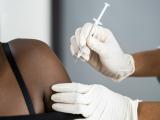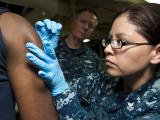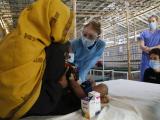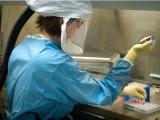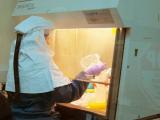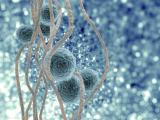Jan 10, 2007 (CIDRAP News) The anthrax-laced letter sent to Sen. Tom Daschle's office in 2001 may have affected more people than was recognized at the time, but the antibiotics and vaccinations given to potentially exposed people were highly effective, according to an immunologic study of the event.
Scientists who prospectively studied people who were in the vicinity when the letter was opened report that even people who were outside the building showed immune responses to anthrax, suggesting that the deadly spores spread more widely than expected. The letter was one of several mailed to two US senators and several media offices in the fall of 2001, resulting in 22 cases of anthrax, 5 of them fatal.
The researchers, writing in the Journal of Infectious Diseases, also report that those who were exposed showed immune responses to anthrax even though they were immediately put on preventive antibiotic treatment. Further, they found that 3 doses of anthrax vaccine adsorbed (AVA)versus the standard 6-dose regimentriggered a strong immune response in those who were vaccinated after the attack.
"Despite postexposure prophylaxis with antibiotics, inhalation of B[acillus] anthracis spores resulted in stimulation of the immune system and possibly subclinical infection, and the greater the exposure, the more complete the immune response," says the report by Denise L. Doolan of the Naval Medical Research Center in Silver Spring, Md., and associates from there and several other institutions.
The researchers studied 124 people, divided into seven groups. The first four groups consisted of (1) 28 people who were in or near Daschle's office and had positive nasopharyngeal cultures for anthrax, (2) 31 who were in or near the office but had negative cultures, (3) 24 who were elsewhere in the Hart Senate Office Building, and (4) 20 who were outside the building but in the Capitol area (and were presumed to be unexposed).
The other three groups, enrolled for comparison, were from outside the Capitol area and consisted of (5) 2 people who had contracted anthrax infections as a result of previous attacks in 2001, (6) 12 with no anthrax exposure, and (7) 7 who were unexposed but had previously been vaccinated against anthrax.
All the volunteers in groups 1, 2, and 3 (those in the building when the letter was opened) were given antibiotic treatment immediately, and 10 of the 20 people in group 4 (those outside the building but in the vicinity) also opted to take antibiotics. In addition, 51 of the 59 people in groups 1 and 2 received 3 doses of anthrax vaccine starting several weeks after the attack.
Two tests (enzyme-linked immunosorbent assay and fluorescence-activated cell sorting) were used to examine the subjects' antibody and cell-mediated immune (CMI) responses to two anthrax proteins: protective antigen (PA) and lethal factor (LF).
Anthrax was found in the nasopharyngeal samples of slightly less than half (47.5%) of workers in groups 1 and 2, including all 13 who were in the office where the letter was opened and lesser proportions of those in adjoining offices. None of the people outside the building had positive samples.
Among nonimmunized people, anthrax antibodies were found only in those who were in the building at the time of the attack, mostly in those who were in Daschle's offices (when tested before vaccination).
In the tests for CMI, the researchers found a direct relationship between presumed anthrax exposure and response rate. Unexpectedly, however, they found evidence of CMI in some people who were outside the building (group 4). For example, monocytic responses were detected in more than 70% of groups 1 and 2, 37.5% of group 3, and 30% of group 4. Monocytic responses for group 4 were significantly higher than those for unexposed controls (group 6).
This finding could mean that the Capitol area generally was contaminated with anthrax, which fits with certain environmental sampling data, or it could mean that some subjects were exposed to the anthrax envelope before it was opened or had contact with those in groups 1 and 2, the article says.
The researchers also report an inverse relationship between CMI responses and antibiotic treatment, which suggested that the treatment impeded anthrax spore germination, the report says.
The postexposure 3-dose vaccination schedule was "highly immunogenic," given that anti-PA antibodies were found in more than 94% of subjects and CMI responses were seen in more than 86%, the researchers write. In other studies, 99% to 100% seroconversion was seen with a preventive 3-dose schedule. The standard anthrax vaccination schedule, used in the US military, involves 6 doses over 18 months.
In the previously vaccinated volunteerswho were revaccinated during the studyimmune responses were strong even after a single new dose of vaccine.
No significant differences in symptoms were seen between subjects with and without anthrax exposure and with and without immune responses, except for headache, which was more common in exposed people but correlated with the duration of antibiotic use.
"Our data demonstrate that exposure to B. anthracis spores primed antibody and cellular responses in a dose-dependent and antigen-specific manner in immunized and unimmunized subjects, enhanced AVA-boost responses, and boosted recall responses in previously immunized subjects," the researchers write.
The data suggest, they add, that low-level anthrax exposure induces asymptomatic cellular immune responses without antibodies and that intermediate exposure induces both cellular and antibody responses.
They conclude that antibiotic treatment protected the infected subjects, who were generally young, from becoming clinically ill. "We do not know whether higher exposure could result in clinical disease even with antibiotics or what happens in immunocompromised or immunologically immature populations," they state.
Doolan DL, Freilich DA, Brice GT, et al. The US Capitol bioterrorism anthrax exposures: clinical epidemiological and immunological characteristics. J Infect Dis 2007 Jan 15;195(2):174-84 [Full text]
See also:
Hadler JL. Learning from the 2001 anthrax attacks: immunological characteristics. (Editorial) J Infect Dis 2007 Jan 15;195(2):163-4 [Full text]
